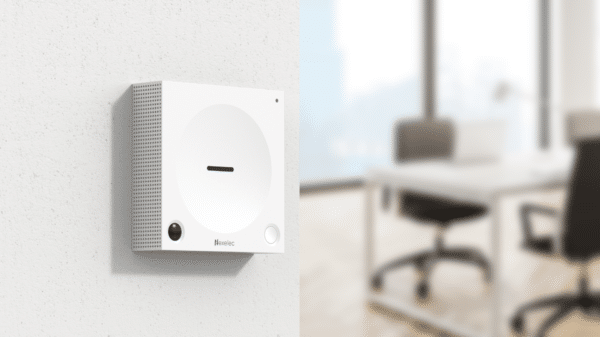There is a real interest in air quality, energy consumption and its impact on employee health and productivity. And with good reason: the indoor environments where you and your employees spend most of your time have a direct influence on your carbon footprint. This also has an impact on your company’s overall performance. Among the critical factors to monitor, carbon dioxide (CO2) levels play a key role.
In the workplace, reducing carbon dioxide levels by 40% significantly improves employee performance. By controlling your emissions and optimising energy consumption, you are helping to reduce environmental impact. It also improves your carbon footprint. Proactive management of greenhouse gases (GHGs), incorporating precise data on emission scopes, is crucial. This helps to limit climate impact and adopt sustainable practices.

Understanding carbon dioxide and its effects
Carbon dioxide is a naturally occurring molecule made up of carbon and oxygen. It is produced mainly by breathing and various industrial processes. Unlike carbon monoxide (CO), which is toxic and potentially fatal, carbon dioxide (CO2) is harmless in small doses. It is a natural part of the air we breathe. However, too much exposure in poorly ventilated enclosed spaces can affect your health, including
- Headaches
- Fatigue
- Difficulty concentrating
- Increased risk of asthma
To limit these impacts on health and your company’s environmental footprint, it is essential to set up a precise calculation of emissions. It is also essential to monitor your energy data. Effective management of greenhouse gases can improve air quality, reduce your energy consumption and limit your carbon footprint.
Sources of carbon dioxide emissions in France
Before focusing on indoor environments, it is important to understand the origins of carbon dioxide (CO2) emissions on a national scale:
- 40%: Transport – Optimise your travel to reduce Scope 3 emissions.
- 24%: Industry – Monitor your energy consumption and evaluate your products.
- 21%: Agriculture – Choose responsible and sustainable products.
- 19%: Buildings and services – Control your energy impact.
- 4%: Waste – Reduce, reuse and recycle to limit your ecological footprint.
In business, a rigorous carbon footprint assessment is necessary to target areas for improvement and adopt sustainable solutions. The data collected will enable you to take action on your emissions, whether from your infrastructure or the products you consume.
The impact of carbon dioxide on productivity
High levels of carbon dioxide (CO2) in a space have a direct impact on employees’ quality of life and performance. Above 1,000 ppm, employees experience a drop in concentration, which reduces productivity and increases absenteeism. This demonstrates the importance of measuring your emissions and reducing the energy consumption associated with buildings.
Poorly ventilated indoor spaces encourage the build-up of carbon dioxide (CO2). This occurs mainly when large numbers of people are grouped together in closed offices or meeting rooms. This highlights the need to monitor air quality in real time to reduce indirect emissions and optimise the use of resources. These actions contribute to better energy management and a reduction in greenhouse gases (GHGs). By integrating innovative products such as CO2 sensors, companies can improve their processes while reducing their environmental impact.
Solutions for reducing carbon dioxide levels
Optimise ventilation: The simplest and most effective method is to air rooms regularly. Opening windows allows excess carbon dioxide (CO2) to escape and improves air quality.
Install CO2 sensors: These measure carbon dioxide (CO2) levels every five minutes and alert you if a critical threshold is reached. This allows you to act quickly. They also provide valuable data on energy consumption and the ecological footprint of spaces. Their place in a sustainable strategy is essential for monitoring emissions and improving processes.
Reducing emissions at source: Adopting sustainable practices and reducing energy consumption in buildings helps to limit overall emissions. Using methods based on renewable sources enables an effective energy transition. Each organisation can put in place a precise calculation of its carbon footprint to better manage the resources and waste it produces. These measures help to develop strategies that are in line with Ademe guidelines. They also help to reduce the impact of greenhouse gases.
Each action improves your company’s carbon footprint and contributes to the sustainable management of greenhouse gases.
The role of sensors in the workplace
Carbon dioxide (CO2) sensors have become essential tools in the management of indoor air quality. By measuring concentrations in real time, they make it possible to :
- Quickly identify poorly ventilated areas
- Adjust ventilation systems as required
- Raise employee awareness of good practice
These sensors are an essential investment for companies that want to ensure a healthy, performance-enhancing environment while complying with Ademe guidelines. They help to reduce energy impact and improve resource management. Good work organisation, taking into account the quality of infrastructures and processes, helps to reduce waste. This also promotes sustainable ecology. Integrating these technologies into day-to-day services and activities helps to limit the quantities of harmful gases. It also reinforces the transition to a sustainable economic model.
Optimum air quality: a key issue
Spending 80% of our time in enclosed spaces makes air quality a priority for every organisation. By reducing carbon dioxide (CO2) levels, employers can improve the health and well-being of their employees, while increasing their productivity.
Carbon dioxide (CO2) sensors offer an effective and affordable solution. Their use is part of a sustainable ecological approach that reduces direct and indirect emissions linked to human activity.
By controlling energy consumption and optimising the use of resources, companies can reduce their carbon footprint. These actions reinforce the positive impact on the environment while placing the quality of life of employees at the heart of our priorities. The transition to sustainable methods, supported by reliable data, is a powerful lever. This will enable us to build a future that is more respectful of the climate and ecosystems. Every company has its place in this dynamic, by implementing responsible processes to reduce greenhouse gases. They are also integrating the principles of sustainable development into their activities.